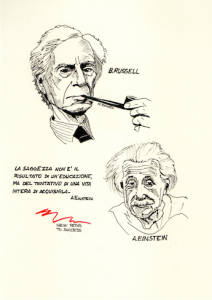Skills are on the rise but wisdom is disappearing
 The title of this piece partially recalls the words of the philosopher Bertrand Russell, cited in my blog post “The Unbearable Lightness of Power” of February 15th.
The title of this piece partially recalls the words of the philosopher Bertrand Russell, cited in my blog post “The Unbearable Lightness of Power” of February 15th.
The complete version of Russell’s thought went something like this:
One of the ills of our age stands in the fact that the evolution of thought cannot keep pace with technology, so that consequently there is an increase in skills, but a vanishing of wisdom.
Effects of this slowness in the evolution of thought are evident on a daily basis:
bad decisions;
problems that constantly come back up because they were never resolved in the first place;
poorly designed products and services;
faulty processes;
companies and businesses apparently frozen in time;
bad management;
etc. etc.; the list could go on quite extensively…
The gap between a thought sometimes stuck in the past, incapable of evolving, and a social and technological environment that is quickly and perpetually changing, causes negative tension (stress, anxiety, demotivation) which risks overwhelming people and companies.
And so, as new technologies increase actual skills and potential for action, wisdom – in the best of scenarios – rests unchanged, and in many other situations, unfortunately, is decreasing.
For the sake of intellectual correctness, it is important to recognize that there are both individuals and companies that have managed to keep up and are making remarkably clear how different they are to organizations which have remained stuck. As always, reflecting upon these exceptions serves us well.
You cannot look at the competition and say that you are going to do better. You have to look at the competition and say that you are going to do things differently.
(Steve Jobs)
It is in “doing things differently” that all the difficulty, as well as tremendous opportunity, are concealed.
Gurus, consultants and professors really love locking up secrets to success in brief formulas (such as those rhetorical messages found in Fortune cookies) or methods which (seemingly) possess merits of simplicity, user-friendliness (the method has already been digested elsewhere), attractiveness (method = recipe = little effort = success = result), predictability (of the result, very popular among managers), scalability (the method extends across the organization) and imitability, (if company X did it and it worked, I can do it too and so will also be successful).
These methods then take on the form either of recipes to apply to companies (I have come across some fun and hilarious ones) or of strategies to draft in order to become marketplace super stars. I wrote about this in Recipes for Disaster (blog post March 29th 2015).
And so, for every manner of problem there is: a) some suitable consultant or specialist; b) a game plan or model to resolve your problem (sometimes as recommended by an expert).
In actual fact, all these methods have two intrinsically fundamental problems.
Firstly, they are explanations a posteriori, or rather, they analyze a series of success cases in order to define the common terms and conditions which produced them, after the fact.
Many researchers, consultants and writers in the field of economics create and put forward strategic visions – snapshots – concerning technologies, companies and markets.
Snapshots give us a picture of a precise moment, that of the shot, the characteristics and business practices of successful organizations vs. those in difficulty, or management prerogatives for achieving the best results.
Explicitly or implicitly, they affirm then that if you want to obtain those same results you must imitate what the best companies and directors do.
Snapshots tell us who is ahead and who is lagging behind in competition, but tell us very little about how they got there and what will happen to them in the future.
(Clayton Christensen)
Secondly, models used to define strategy, or product development, or more generally, innovation processes, cannot give us the RIGHT IDEA, which is what makes all the difference and must be looked for by the person using the model.
What is truly important is not so much the model (which is a conventional model, simplified compared to the more complex reality of a problem, a phenomenon, an object, a mechanism, a process) as the idea. And furthermore, if we find the right idea, the model then serves retrospectively to conceptualize what has been done.
Our fascination with models and game plans is undoubtedly great and many consultants and academics adopt them in order to provide “ready to use solutions” (like a food sauce) in the most diverse business environments. The results are clear to everyone.
If only a fraction of the miracles promised came to pass, there would be thousands of success cases out there. Instead, reality is quite different. Essentially, these strategies and models create success for those selling them and writing about them in books.
Just as purchasing a paintbrush will not make an artist of you and owning the same brand of shoes as a successful footballer will not transform you into a world-class soccer player, so too are there zero short-cuts where dedication, effort and discipline are involved.
Models for success can be useful instruments, if they are used correctly, for reflecting and reasoning, but they are by no means a philosopher’s stone, sought in vain for centuries by alchemists in order to transmute lead into gold. Harry Potter is a work of fiction, and confusing the unreal with the real creates dissociation that can lead one towards neurosis or madness.
There cannot be any substitute for thought: thinking is one of the most effective problem-solving weapons. (Nelson Mandela)
Here I refer to good thinking, a discipline worth dedicating some effort to, and which, above all, we can learn to do and get better at with practice.
Never place your trust, therefore, in strategies and models, which are just that: representations of reality and not actual reality itself (the map is not the territory!) but use them for what they can give; a structure for reasoning, which must however subsequently be able to assist in generating ideas and original alternatives or, in the case of problem solving, help come up with solutions which eradicate the fundamental causes of the problem.
Evolution of thought increases our ability to think, to produce new and original ideas, to face real problems and keep in mind values which can not be forgotten when dealing with certain types of problems.
The concept of Wisdom refers traditionally to a precise sphere of human activity and is expressed in rational conduct in this context, which is to say that it describes the ability to manage conduct in the best possible way. Wisdom is not about high and sublime knowledge, remote from our shared humanity, like Sapience: it is understanding human affairs and the most suitable way of going about them (Nicola Abbagnano).
Wisdom requires good a usage of thought, behavior and action, sensitivity, empathy, consideration of others and of values as a sort of guide, a quality of spirit and of operating, often sacrificed and forgotten because of inability and incompetence as well as a prevalence of short-term and myopic logic.
A good leader has to be a wise person who knows how best to conduct human affairs, because it is in the interests of a company, of a community, of people themselves and, perhaps more fundamentally, because it is simply right; it is what we expect leaders to do if they want to be such in fact and not just in name.
We need to recover thinking time, time for communicating and for dialogue, to find time to listen to people and facilitate their growth. We must take good care both of our new skills afforded us by technology and of our softer skills, that are necessary for guiding people.
Hardware, software and human touch?
Wisdom is not about governing others, but about governing ourselves, said Lao-Tsu (Simplicity); one quality of a leader is therefore equilibrium and self-knowledge; after all, if a leader cannot guide herself, how can she guide others?
Therefore the wise do not use knowledge to exploit and do not allow their desires to destroy their harmony. When they are happy they do not become agitated and when they are sad they are not distressed and hopeless. Thus they are safe even in high places; they are secure and stable. (Lao-Tsu)
These complex, enmeshed and tempestuous times call for originality, reflection, action, wisdom and vision. These are not to be found in the strategies of gurus, or in technology, but in constant exploration and in a desire for ongoing learning and improvement, building the self as a leader every day, learning from mistakes and being guided by the heart and mind, finding the time to stop and think.
Following means combining events so as to harmonize them with the times. Constant changes leave no room for pause: if you take action in advance, you’re too far forward; if you act too late, you have lost an opportunity.
Days and months pass, and time waits for no man. For this reason, the wise appreciate having a bit of time over having a great gem.
Time is difficult to find and easy to lose. (Lao-Tzu)
Finding the time to think “well” makes us more efficacious and better.
Wishing you much time and wisdom,
Massimo

